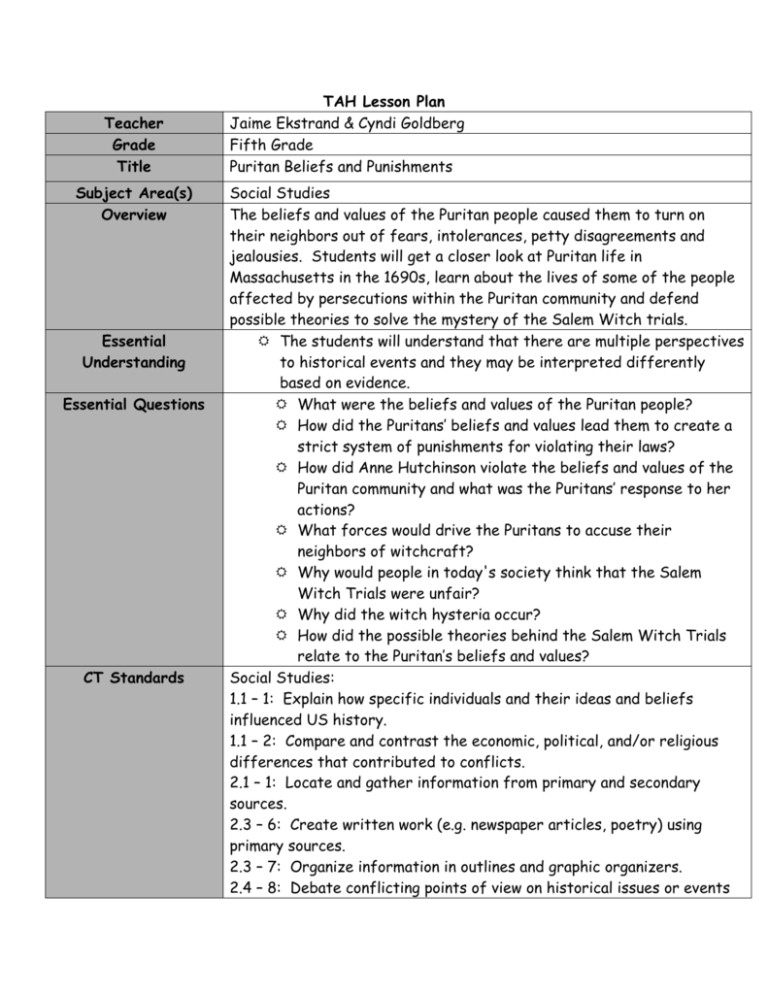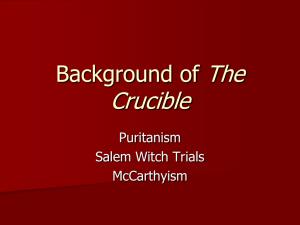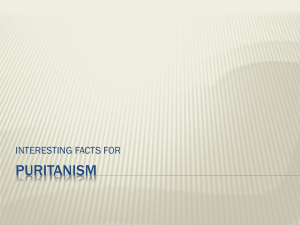Puritan Beliefs and Punishments
advertisement

Teacher Grade Title Subject Area(s) Overview Essential Understanding Essential Questions CT Standards TAH Lesson Plan Jaime Ekstrand & Cyndi Goldberg Fifth Grade Puritan Beliefs and Punishments Social Studies The beliefs and values of the Puritan people caused them to turn on their neighbors out of fears, intolerances, petty disagreements and jealousies. Students will get a closer look at Puritan life in Massachusetts in the 1690s, learn about the lives of some of the people affected by persecutions within the Puritan community and defend possible theories to solve the mystery of the Salem Witch trials. The students will understand that there are multiple perspectives to historical events and they may be interpreted differently based on evidence. What were the beliefs and values of the Puritan people? How did the Puritans’ beliefs and values lead them to create a strict system of punishments for violating their laws? How did Anne Hutchinson violate the beliefs and values of the Puritan community and what was the Puritans’ response to her actions? What forces would drive the Puritans to accuse their neighbors of witchcraft? Why would people in today's society think that the Salem Witch Trials were unfair? Why did the witch hysteria occur? How did the possible theories behind the Salem Witch Trials relate to the Puritan’s beliefs and values? Social Studies: 1.1 – 1: Explain how specific individuals and their ideas and beliefs influenced US history. 1.1 – 2: Compare and contrast the economic, political, and/or religious differences that contributed to conflicts. 2.1 – 1: Locate and gather information from primary and secondary sources. 2.3 – 6: Create written work (e.g. newspaper articles, poetry) using primary sources. 2.3 – 7: Organize information in outlines and graphic organizers. 2.4 – 8: Debate conflicting points of view on historical issues or events using evidence. 3.1 – 1: Identify and explain different points of view about a historical event. 3.2 – 4: Describe views and feelings of people in the past using personal experience and/or outside readings. Objectives Materials The students will be able to explain how the Puritan’s ideas and beliefs shaped their community and led to of the banishment of Anne Hutchinson and the Salem Witch Trials. The students will be able to use primary and secondary sources to analyze the accusations that led to persecution, determine their fairness and defend one of four major theories about the Salem Witch Trials. The students will be able to utilize historical inquiry to make their own decisions and form theories about historical people. The students will create their own theories/hypothesis and use historical evidence to support them. Websites: Video: “The Story of the Witchhunt” http://school.discoveryeducation.com/schooladventures/salemwitchtrials/story/ Secondary and Primary Sources: “The People” http://school.discoveryeducation.com/schooladventures/salemwitchtrials/people/ The Salem Witch Trials Maps http://www.iath.virginia.edu/salem/maps.html Books: The Salem Witch Trials: An Unsolved Mystery from History by Jane Yolen Life Among the Puritans by Louise Chipley Slavicek Hands-On History: Colonial America by Michael Gravois 5 copies of: You Wouldn’t Want to Be a Salem Witch! by Jim Pipe Mysteries in History: American History by Wendy Conklin Handouts: Puritan Life Anticipatory Guide Note-taking handout – Massachusetts Bay Puritan Portrait handouts Puritan beliefs and values YES response sheets Note-taking handout – Punishments Diamante Poem handout Venn Diagram Anne Hutchinson passage Cause and Effect graphic organizers Letter to Anne Hutchinson Anne Hutchinson YES response sheets Salem Witch Trials Graphic Organizer from: Mysteries in History: American History. Obituary and Tombstone handouts The Salem Witch Trials: Rebecca Nurse’s Trial found in: Mysteries in History: American History The Salem Witchcraft Theories Overview – Homework The Salem Witchcraft Theories handouts The Salem Witch Trials Theories graphic organizer Editorial Graphic Organizer Materials: Highlighters Bulletin Board paper Bulletin Board letters Markers / Crayons / Colored Pencils Equipment: Smartboard or overhead projector On-line computers for each cooperative learning group Day 1 Puritan Way of Life Details of the Activity The teacher will begin the unit by distributing the Puritan Life Anticipatory Guide for each student to complete. The teacher will discuss the previous taught lesson on the Pilgrims and the religious motivations of the colonization of Plymouth. The teacher will then explain that we are studying the next colony of Massachusetts Bay which was settled by a group of people called the Puritans. Day 2 Puritan Punishments The teacher and students will begin completing the note-taking handout, Massachusetts Bay, in order to provide the students with a quick overview of the settling of the colony, using the Smartboard and graphic organizer. The students will work in cooperative learning groups to read pages 89 entitled, “The Puritans” found in the book, You Wouldn’t Want to Be a Salem Witch!, and complete the notes by listing the strict Puritan rules and laws. With selected students, the teacher(s) will role-play each rule and the students will identify the rule being portrayed. The teacher will add the rules to the notes on the Smartboard or overhead. The teacher(s) will distribute the handouts for the Puritan Portrait assignment and explain the directions. The students will complete the assignment in their cooperative learning groups. As an exit ticket, the students will complete the After Reading section of the Puritan Life Anticipatory Guide. Homework Respond to the open-ended question, “What was a belief or value of the Puritan people?” (Modified with answer frames and tip boxes with sentence starters for below-level learners). Details of the Activity The teachers and self-selected students will role-play Puritans violating a law learned in the previous day’s lesson. The teachers will pose the question, “How did the Puritans punish these people who were breaking their laws?” Students will break out into a quick Think-Pair-Share to list and share the ways modern society punishes those who break their laws and record them on the Punishments note-taking sheet. The teachers and students will complete the note-taking handout, Punishments, as the teachers present the various consequences of breaking the laws in the Puritan community, through non-linguistic representations of the punishments (i.e., pictures of the dunking stool, brandings, stocks, pillory, etc.) using the Smartboard or overhead. The teachers will read the section entitled, “The Invisible World: The Battle Between Good and Evil” found on pages 32-33 in the book, Life Among the Puritans. The students will complete a Venn diagram comparing and contrasting modern and Puritan Day 3 Anne Hutchinson and Her Trial and Banishment Day 4 Witchcraft Accusations punishments. The teachers and students will then discuss how the Puritan punishments, designed to be quick, humiliating and severe, reflected their beliefs in the common good and the battle between good and evil. The teachers and students will complete the note-taking sheet. The students will create a Diamante Poem to describe the Puritan punishments. Homework Using their Punishments notes, the students will identify the similarities and differences (modified with labels and sentence starters for below-level learners). Details of the Activity The teachers and students will read the passage, “Anne Hutchinson”. The students will perform a play entitled “Anne Hutchinson, An Outspoken Woman” found in Hands-On History: Colonial America. The teachers will model the completion of a cause and effect graphic organizer on the Smartboard or overhead to identify the actions of Anne Hutchinson that violated the beliefs and values of the Puritan community (causes) and led to her trial and banishment (effect). The teachers will read the directions and letter from Anne Hutchinson and model the student reply by identifying how various beliefs and values would determine whether a person would attend her meetings or not. The students will reply to the letter from Anne Hutchinson (modified for below-level learners with answer frames completed in small cooperative learning groups facilitated by an adult). Homework Respond to the open-ended question, “What caused Anne Hutchinson to be banished from the Massachusetts Bay Colony?” (Modified with answer frames and tip boxes with sentence starters for below-level learners). Details of the Activity The teacher(s) will dim the lights and use the Smartboard to play the video, “The Story of the Witch Hunt”, found on the Discovery Education website. Using the Smartboard, the teachers will go online to view the Day 5 Causes of the Witchcraft Hysteria Salem witch trial maps. The class will examine the Ipswich map of Salem and determine how the locations of the accused and the accusers related to where they lived and the role the road played in creating tensions between the people of Salem Village and Salem Town. The students will be divided into four cooperative learning groups and be assigned a member of the Puritan community who was accused of witchcraft by the young girls of Salem (John Proctor, Tituba, Mary Easty, Sarah Good). The teachers will model all activities with the accused, Rebecca Nurse. The teachers will read a biographical paragraph about Rebecca Nurse and use the Smartboard to model the completion of a Cause and Effect graphic organizer to identify the reasons Nurse was accused and the punishments she received as a result. Each group will then be given a laptop to access secondary and primary sources found on “The People” section of the Discovery Education website regarding their accused witch or wizard. Each group will complete the Cause and Effect graphic organizer as modeled. Each group will share their Cause and Effect graphic organizers with the option of acting out the scenario that illustrates the causes and effects of the accusations. Following each group’s presentation, teachers and students will summarize the accusations, using The Salem Witch Trials graphic organizer found on page 37 of the book, Mysteries in History: American History. Teachers will model the writing of an obituary and tombstone of Rebecca Nurse. Homework Write an obituary or draw a tombstone with an epitaph that explains who their person was, why they were accused, and what their punishment was. Details of the Activity Teachers will accuse each other and members of the class of being witches, based on accusations learned the previous day (e.g. you like cats, you have a mole, you can spell). Teachers will pose the question, “Were the accusations fair? Can the evidence of guilt be proven?” Day 6 The Theories Behind the Witchcraft Hysteria Teachers will ask the cooperative group who was responsible for the cause and effect graphic organizer for Rebecca Nurse to share the details of her accusations. This group will then act out the play, “The Salem Witch Trials: Rebecca Nurse’s Trial” found on pages 41-43 in the Mysteries of Histories: American History book. After the performance, the students will work in a Think-PairShare to highlight the evidence used against Rebecca Nurse and judge whether this evidence is fair (Can it be proven?) Teachers will pose the question, “What would motivate the girls to begin accusing people in Salem of witchcraft?” Students will work in a Think-Pair-Share to list ideas on why the girls would accuse people of witchcraft. Teachers will present the students with the handout, “The Salem Witchcraft Theories Overview” Homework Students will read “The Salem Witchcraft Theories Overview” handout and choose a theory by checking it. Details of the Activity Teachers will review the theories given in the handout, “The Salem Witchcraft Theories Overview”. The students will be grouped according to their selected theory completed for homework. Each group will receive a handout pertaining to their chosen theory. They will read the questions posed at the top of the handout, read the information below, and highlight the answers to the questions found in the passage. The teachers will model the completion of an editorial to describe the unfairness of the trial of Anne Hutchinson. The students will then independently complete an editorial to describe the theory they believe caused the young girls of Salem to accuse people of witchcraft. Teachers will show the primary source document found on “The People” section of the Discovery Education website regarding Ann Putnam’s apology that took place twelve years after the Salem witch trials. The teachers will pose the question, “How is Ann’s apology based on her Puritan beliefs and values?” Homework The students will draw an illustration with a caption to support their editorial. Suggested Assessment/Evaluation Rubric Possible Extensions/Resources Assess the students on their daily assignments using the Puritan Projects Rubric. Culminating Assessment: Students will write a summary of the Puritan way of life by answering the question, “How did the Puritan’s beliefs and values lead to the persecutions of many people in their community?” View actual gravestones from the time period by visiting the Farber Gravestone Collection at http://luna.davidrumsey.com to compare and contrast modern and colonial gravestones. Create an oversized newspaper bulletin board titled, “The Puritan Paper” comprised of the Puritan Portraits, the obituaries, the editorials and illustrations. Students can create advertisements, word searches, crossword puzzles, and/or comic strips for the Massachusetts Bay Colony and the Puritan way of life to add the bulletin board.






